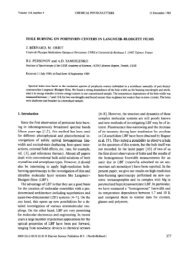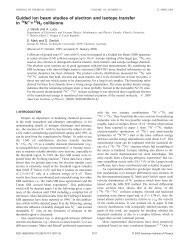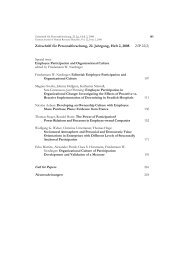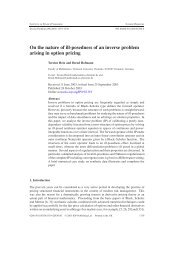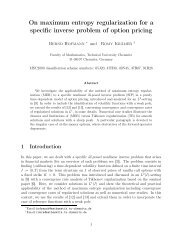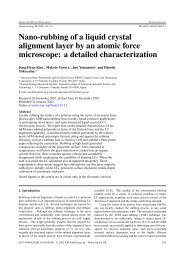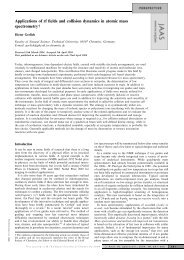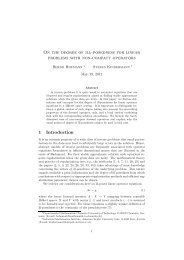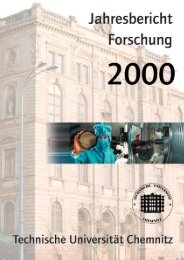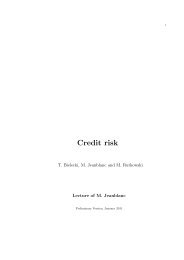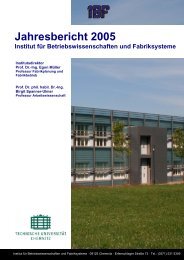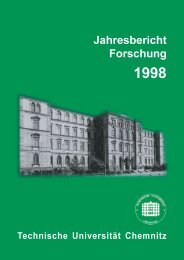Deuterium fractionation in gas-phase reactions measured in the ...
Deuterium fractionation in gas-phase reactions measured in the ...
Deuterium fractionation in gas-phase reactions measured in the ...
Create successful ePaper yourself
Turn your PDF publications into a flip-book with our unique Google optimized e-Paper software.
Abstract<br />
Available onl<strong>in</strong>e at www.sciencedirect.com<br />
Planetary and Space Science 50 (2002) 1287 – 1297<br />
<strong>Deuterium</strong> <strong>fractionation</strong> <strong>in</strong> <strong>gas</strong>-<strong>phase</strong> <strong>reactions</strong> <strong>measured</strong><br />
<strong>in</strong> <strong>the</strong> laboratory<br />
D. Gerlich ∗ , S. Schlemmer<br />
Department of Physics, Technische Universitat Chemnitz, 09107 Chemnitz, Germany<br />
Received 21 January 2002; received <strong>in</strong> revised form 15 April 2002; accepted 17 June 2002<br />
www.elsevier.com/locate/pss<br />
In order to understand quantitatively <strong>the</strong> enrichment of deuterated molecules observed <strong>in</strong> non-equilibrium environments such as <strong>in</strong>terstellar<br />
clouds, one has to know <strong>in</strong> detail many state-to-state cross sections. For detailed models, one has to treat both chemical processes such as<br />
formation and destruction of <strong>the</strong> isotopomers and physical processes such as collisional excitation and radiative transitions of <strong>the</strong> relevant<br />
molecular states. This contribution gives a short summary of experimental techniques <strong>in</strong> <strong>the</strong> eld of low-energy <strong>gas</strong>-<strong>phase</strong> collisions<br />
such as ow techniques, traps, and beam methods with special emphasis on those methods which can be used to study <strong>the</strong> dynamics of<br />
H–D scrambl<strong>in</strong>g. The situation is illustrated with <strong>the</strong> astrophysically important H + +H2 collision system <strong>in</strong> several isotopic variants. This<br />
fundamental system is well understood, and most experimental results are <strong>in</strong> good accordance with predictions from a dynamically biased<br />
statistical model. Less well understood are <strong>the</strong> di erent isotopic comb<strong>in</strong>ations of H + 3 collid<strong>in</strong>g with H2. The H + 3 + HD variant is discussed<br />
<strong>in</strong> a separate paper <strong>in</strong> this special issue (H + 3 +HD↔ H2D + +H2:low-temperature laboratory measurements and <strong>in</strong>terstellar implications,<br />
Planet. Space Sci., this volume) while, <strong>in</strong> this contribution, <strong>the</strong> situation is illustrated with rate coe cients for isotopic exchange <strong>in</strong><br />
D + 3 +H2 collisions. O<strong>the</strong>r examples <strong>in</strong>clude <strong>the</strong> study of deuteration of hydrocarbon ions <strong>in</strong> a trap at a nom<strong>in</strong>al temperature of 10 K. In<br />
particular, <strong>the</strong> rate coe cients for sequential deuteration of C2H + 2 <strong>in</strong> collisions with HD have been <strong>measured</strong> to be 7:5×10 −10 cm 3 s −1 and<br />
7:0×10 −10 cm 3 s −1 . Ano<strong>the</strong>r example refers to <strong>the</strong> <strong>reactions</strong> that occur when CH + 3 is stored <strong>in</strong> para-hydrogen (p-H2) or normal-hydrogen<br />
(n-H2) conta<strong>in</strong><strong>in</strong>g <strong>the</strong> natural abundance of HD. At <strong>the</strong> low densities used, H–D exchange competes only with radiative association. Some<br />
h<strong>in</strong>ts to <strong>the</strong> next generation of experiments are given. One of <strong>the</strong> aims is to study <strong>the</strong> role of H atoms and D atoms <strong>in</strong> low-temperature<br />
<strong>gas</strong>-<strong>phase</strong> chemistry. Ano<strong>the</strong>r aim is to comb<strong>in</strong>e laser and trapp<strong>in</strong>g techniques <strong>in</strong> order to get both state speci c rate coe cients and<br />
spectroscopic <strong>in</strong>formation.<br />
? 2002 Elsevier Science Ltd. All rights reserved.<br />
Keywords: Laboratory astrochemistry; Reactive collisions; Deuteration; Nuclear sp<strong>in</strong>; ISM: molecules; p-H2 o-H2; D2H + ;H2D + ;CH + 3 ;CH5; C2H + 2<br />
1. Introduction<br />
The chemistry of <strong>the</strong> <strong>in</strong>terstellar medium is vastly different<br />
from o<strong>the</strong>r chemical systems s<strong>in</strong>ce low densities of<br />
electrons, atoms and molecules (¡ 10 7 cm −3 ) and low temperatures<br />
(10 K <strong>in</strong> dense molecular clouds) prevail. Therefore,<br />
small endo<strong>the</strong>rmicities or barriers as well as excitation<br />
of <strong>the</strong> reactants to low-ly<strong>in</strong>g ne structure or rotational states<br />
can change <strong>the</strong> outcome of <strong>reactions</strong> signi cantly and m<strong>in</strong>or<br />
ga<strong>in</strong>s <strong>in</strong> zero-po<strong>in</strong>t energies caused by suitable isotopic<br />
rearrangement play a key role. In addition <strong>the</strong> mass dependence<br />
of centrifugal barriers and symmetry selection rules<br />
∗ Correspond<strong>in</strong>g author. Fax: +49-371-531-3103.<br />
E-mail address: gerlich@physik.tu-chemnitz.de (D. Gerlich).<br />
0032-0633/02/$ - see front matter ? 2002 Elsevier Science Ltd. All rights reserved.<br />
PII: S0032-0633(02)00095-8<br />
a ect <strong>the</strong> outcome of a chemical reaction when identical<br />
atoms are substituted by dist<strong>in</strong>guishable isotopes. The last<br />
po<strong>in</strong>t is discussed <strong>in</strong> more detail <strong>in</strong> ano<strong>the</strong>r contribution<br />
(Gerlich et al., 2002).<br />
Stable isotopes of several elements, D, 13 C; 15 N and o<strong>the</strong>rs,<br />
have been detected <strong>in</strong> <strong>in</strong>terstellar molecules. In order to<br />
correlate quantitatively XD/XH ratios with parameters such<br />
as (i) D / H isotope ratio, (ii) ambient temperatures, and<br />
(iii) density of atoms, molecules, and electrons, one has to<br />
know <strong>in</strong> detail <strong>the</strong> k<strong>in</strong>etics and dynamics of a variety of processes<br />
<strong>in</strong>clud<strong>in</strong>g chemical <strong>reactions</strong>, <strong>in</strong>elastic collisions and<br />
radiative transitions. The <strong>reactions</strong> and parameters used <strong>in</strong><br />
present <strong>gas</strong>-<strong>phase</strong> chemistry models lead to <strong>the</strong> conclusion<br />
that deuterium <strong>fractionation</strong> is dom<strong>in</strong>ated by <strong>the</strong> molecules<br />
HD; H2D + ; CH2D + ; C2HD + <strong>the</strong> abundance ratio of which,<br />
XD/XH, is much larger than <strong>the</strong> elemental ratio of typically
1288 D. Gerlich, S. Schlemmer / Planetary and Space Science 50 (2002) 1287 – 1297<br />
D=H =2× 10 −5 (Millar et al., 1989). In recent years, <strong>the</strong><br />
activities of <strong>in</strong>terstellar gra<strong>in</strong>s <strong>in</strong> isotope exchange and enrichment<br />
have also been accounted for (Millar, 2002).<br />
Molecular rotational emission at far-IR and sub-millimeter<br />
wavelengths are very e ective probes of <strong>in</strong>terstellar and<br />
circumstellar molecules and <strong>the</strong> next generation <strong>in</strong>struments<br />
such as Herschel will signi cantly broaden our knowledge.<br />
In <strong>the</strong> case of some symmetric molecules with equivalent<br />
hydrogen atoms, a signi cant dipole moment can result<br />
from an H–D substitution. The most obvious example is<br />
<strong>the</strong> HD molecule, which has been observed <strong>in</strong> emission<br />
via a pure rotational transition at 112 m. O<strong>the</strong>r examples<br />
<strong>in</strong>clude H2D + ; C2HD + or cyclic C3H2D + , o<strong>the</strong>r candidates<br />
are deuterated PAH’s. In order to evaluate <strong>the</strong> observations,<br />
<strong>measured</strong> <strong>in</strong>tensities have to be correlated to <strong>the</strong> formation<br />
and destruction of <strong>the</strong>se molecules and, possibly, to collisional<br />
or o<strong>the</strong>r pump<strong>in</strong>g processes. In order to predict this<br />
with realistic models, state-to-state cross sections at collision<br />
energies of a few meV or low temperature state speci<br />
c rate coe cients for a variety of <strong>in</strong>elastic and reactive<br />
collision processes are needed.<br />
Isotope exchange has been used often <strong>in</strong> experiments <strong>in</strong><br />
order to get detailed <strong>in</strong>formation on <strong>the</strong> microscopic dynamics.<br />
Recent examples from this laboratory <strong>in</strong>clude deuteration<br />
of hydrogen clusters (Paul et al., 1996), isotope exchange<br />
<strong>in</strong> H − +D2 collisions (Hau er et al., 1997) or near<br />
symmetric charge transfer <strong>in</strong> 36 Ar + + 40 Ar collisions (Pull<strong>in</strong>s<br />
et al., 2000). Interest<strong>in</strong>g is also <strong>the</strong> restricted scrambl<strong>in</strong>g <strong>in</strong><br />
15 N + + 14 N2 collisions because <strong>the</strong> atoms do not have equivalent<br />
positions <strong>in</strong> <strong>the</strong> l<strong>in</strong>ear complex (Glosik et al., 2000).<br />
Ano<strong>the</strong>r po<strong>in</strong>t of fundamental <strong>in</strong>terest for isotope exchange<br />
is <strong>the</strong> <strong>in</strong> uence of zero-po<strong>in</strong>t energy <strong>in</strong> <strong>the</strong> transition region if<br />
a reaction is h<strong>in</strong>dered by a small barrier. Such an observation<br />
has been reported for <strong>the</strong> collision system C3H + +H2 and<br />
its isotopic variants, where H–D exchange competes with<br />
hydrogen abstraction and radiative association (Sorgenfrei<br />
and Gerlich, 1994).<br />
Most of <strong>the</strong> experimental <strong>in</strong>formation for isotope exchange<br />
used <strong>in</strong> current models (Millar et al., 1997; Roberts<br />
and Millar, 2000) has been obta<strong>in</strong>ed several decades ago.<br />
In <strong>the</strong> 1970s, <strong>the</strong> detection of more and more <strong>in</strong>terstellar<br />
molecular species and <strong>the</strong> determ<strong>in</strong>ation of <strong>the</strong>ir relative<br />
abundances has stimulated <strong>the</strong> development of various laboratory<br />
experiments for study<strong>in</strong>g <strong>gas</strong>-<strong>phase</strong> ionic <strong>reactions</strong><br />
and <strong>the</strong>ir extension to appropriately low temperatures. It<br />
also should be noted that <strong>the</strong> laboratory studies have revealed<br />
important routes for <strong>the</strong> syn<strong>the</strong>sis of <strong>in</strong>terstellar<br />
molecules and have <strong>in</strong>dicated important new classes of<br />
<strong>reactions</strong> speci c to <strong>in</strong>terstellar chemistry. One example<br />
is radiative association (Smith, 1993). This contribution<br />
brie y summarizes <strong>in</strong> Section 2 <strong>the</strong> experimental activities<br />
<strong>in</strong> <strong>the</strong> eld of low-energy <strong>gas</strong>-<strong>phase</strong> collisions. A few<br />
h<strong>in</strong>ts to recent developments us<strong>in</strong>g traps and various beam<br />
techniques are given. In Section 3, results are reported for<br />
H + ; H + 3 ; C2H + 2 and CH+ 3 ions collid<strong>in</strong>g with well-de ned<br />
mixtures of p-H2; o-H2 and HD or D2. Isomerization and<br />
deuteration of HOC + <strong>in</strong> collisions with H2 and HD and <strong>the</strong><br />
formation of DCO + <strong>in</strong> collisions with HD, mentioned <strong>in</strong><br />
<strong>the</strong> conference contribution, will be discussed <strong>in</strong> a separate<br />
paper.<br />
2. Experimental<br />
It is obvious that special experimental techniques are<br />
needed to study collision processes under <strong>in</strong>terstellar conditions.<br />
The three types of experiments which are brie y discussed<br />
<strong>in</strong> <strong>the</strong> follow<strong>in</strong>g, are swarm techniques, beam methods,<br />
and ion traps. In general, low temperatures are achieved<br />
by cryogenic cool<strong>in</strong>g or by supersonic expansions. In several<br />
modern laboratories, laser-based methods are comb<strong>in</strong>ed<br />
with <strong>the</strong>se techniques to obta<strong>in</strong> <strong>in</strong>formation on state-speci c<br />
rate coe cients. Typical criteria for compar<strong>in</strong>g <strong>the</strong> advantages<br />
and disadvantages of speci c <strong>in</strong>struments are based<br />
on ion preparation (mass and <strong>in</strong>ternal energy), compet<strong>in</strong>g<br />
<strong>reactions</strong> (e.g. cluster formation), condensation of <strong>the</strong> neutral<br />
species on <strong>the</strong> walls, number density range (radiative<br />
association), sensitivity (<strong>in</strong>teraction times) and detection efciency<br />
(discrim<strong>in</strong>ation).<br />
2.1. Swarm techniques<br />
Many ion–molecule <strong>reactions</strong> have been studied us<strong>in</strong>g<br />
ow<strong>in</strong>g afterglow (FA) and selected-ion ow tube (SIFT)<br />
techniques and a large body of k<strong>in</strong>etic and <strong>the</strong>rmodynamic<br />
data has been obta<strong>in</strong>ed. The experimental <strong>in</strong>vestigation of<br />
<strong>reactions</strong> relevant to <strong>in</strong>terstellar chemistry owes much to <strong>the</strong><br />
work of Adams and Smith who used a variable-temperature<br />
selected-ion ow tube (VT-SIFT) (Smith and Adams,<br />
1988). S<strong>in</strong>ce <strong>in</strong> <strong>the</strong> SIFT, a mass analyzed beam of ions<br />
is <strong>in</strong>jected <strong>in</strong>to <strong>the</strong> carrier <strong>gas</strong>, it became possible to study<br />
isotope exchange <strong>in</strong> ion–neutral <strong>reactions</strong>. These results,<br />
some of which are mentioned below, have been discussed<br />
<strong>in</strong> several reviews (e.g. Adams and Smith, 1983). By construction,<br />
<strong>the</strong> VT-SIFT was limited to liquid nitrogen temperature<br />
(80 K). A drift tube apparatus that was cooled with<br />
liquid helium has been developed by Bohr<strong>in</strong>ger and Arnold<br />
(1983) <strong>in</strong> Heidelberg. In this device, results at temperatures<br />
as low as 20 K have been obta<strong>in</strong>ed.<br />
Cryogenic cool<strong>in</strong>g has <strong>the</strong> disadvantage that condensation<br />
of <strong>the</strong> target or bu er <strong>gas</strong> restricts its range of<br />
applicability. One solution to exam<strong>in</strong>e <strong>reactions</strong> at low<br />
temperatures which avoids this problem is to use supersonic<br />
expansions. The best known example is <strong>the</strong> CRESU<br />
(C<strong>in</strong>etique de Reaction en Ecoulements Supersoniques Uniformes)<br />
technique (Rowe et al., 1985). In this apparatus<br />
ions are <strong>in</strong>jected <strong>in</strong>to <strong>the</strong> core of a several centimeter thick<br />
supersonic ow of carrier <strong>gas</strong> such as He or N2 conta<strong>in</strong><strong>in</strong>g a<br />
small amount of <strong>the</strong> neutral molecules as reactants. K<strong>in</strong>etic<br />
data at temperatures as low as 8 K have been obta<strong>in</strong>ed.<br />
More details on this technique and a discussion of selected<br />
applications to <strong>in</strong>terstellar chemistry can be found <strong>in</strong> a recent<br />
review by Smith and Rowe (2000). An extension to
D. Gerlich, S. Schlemmer / Planetary and Space Science 50 (2002) 1287 –1297 1289<br />
temperatures below 3 K has been made possible by <strong>the</strong><br />
development of <strong>the</strong> free jet ow reactor by Smith (1998).<br />
Unfortunately, both methods have not yet been used for laboratory<br />
studies of isotope exchange <strong>in</strong> collisions with HD<br />
at <strong>the</strong> respective low temperatures; however, Hawley and<br />
Smith (1992) report rates of isotope exchange of C2H + 2<br />
with D2 and C2D + 2 with H2.<br />
2.2. Beam methods<br />
The only beam method where ion beams with a laboratory<br />
k<strong>in</strong>etic energy of a few meV can be prepared with su cient<br />
<strong>in</strong>tensity is <strong>the</strong> guided ion beam method (GIB), pioneered<br />
by Teloy and Gerlich (1974). Di erent mach<strong>in</strong>es, based on<br />
this technique, have been constructed <strong>in</strong> several laboratories<br />
as summarized by Gerlich (1992). In most GIB <strong>in</strong>struments,<br />
a room temperature scatter<strong>in</strong>g cell is used and <strong>the</strong> <strong>the</strong>rmal<br />
motion of <strong>the</strong> target <strong>gas</strong> sets a lower limit to <strong>the</strong> mean k<strong>in</strong>etic<br />
energy. This problem has been overcome by replac<strong>in</strong>g <strong>the</strong><br />
scatter<strong>in</strong>g cell with a crossed (Tosi et al., 1994) or merged<br />
supersonic beam (Glenew<strong>in</strong>kel-Meyer and Gerlich, 1997).<br />
In pr<strong>in</strong>ciple, <strong>the</strong> idea to merge two beams <strong>in</strong> order to get<br />
low collision energies is already quite old, a rst version of<br />
a merged beam arrangement has been described by Trujillo<br />
et al. (1966).<br />
A more sophisticated merged beam apparatus is <strong>the</strong> arrangement<br />
described by Gerlich (1993). The special feature<br />
of this <strong>in</strong>strument is that <strong>the</strong> fast neutral beam is replaced<br />
by an <strong>in</strong>tense supersonic beam and that, as a consequence, a<br />
slow ion beam is needed. This beam is con ned by a weak<br />
rf eld and guided completely with<strong>in</strong> <strong>the</strong> neutral beam.<br />
Primary and product ions are detected via a quadrupole<br />
mass spectrometer. The <strong>in</strong>ternal temperature of <strong>the</strong> primary<br />
ions and <strong>the</strong> neutrals can be controlled separately between<br />
10 and 300 K by us<strong>in</strong>g a low-temperature ion trapp<strong>in</strong>g<br />
source and a supersonic beam with a temperature variable<br />
nozzle. Collision energies as low as 1 meV have been<br />
achieved.<br />
2.3. Ion traps<br />
Various ion traps have been used s<strong>in</strong>ce <strong>the</strong> 1960s for<br />
study<strong>in</strong>g ion–molecule <strong>reactions</strong>. Us<strong>in</strong>g suitable electric or<br />
magnetic elds, ions can be con ned for long times, and with<br />
<strong>the</strong> use of a bu er <strong>gas</strong> <strong>the</strong>rmal conditions can be atta<strong>in</strong>ed.<br />
The most common techniques used <strong>in</strong> chemistry are <strong>the</strong><br />
ion cyclotron resonance (ICR) apparatus and <strong>the</strong> Paul trap.<br />
Of relevance for <strong>in</strong>terstellar chemistry was <strong>the</strong> development<br />
by Dunn et al. who used a low-pressure Penn<strong>in</strong>g ion trap<br />
that could be operated down to temperatures below 10 K<br />
(Barlow et al., 1986). Ano<strong>the</strong>r recent approach to construct<br />
a dedicated device around a cooled ICR cell is <strong>the</strong> setup<br />
PIRENEA (Piege a Ions pour la Recherche et l’Etude de<br />
Nouvelles Especes Astrochimiques) (Jobl<strong>in</strong> et al., 2000).<br />
It has been speci cally developed for <strong>in</strong>terstellar chemistry<br />
studies <strong>in</strong>clud<strong>in</strong>g large PAH’s and aggregates.<br />
Most data presented and discussed below were obta<strong>in</strong>ed<br />
us<strong>in</strong>g a trapp<strong>in</strong>g technique, based on <strong>in</strong>homogeneous<br />
rf elds. S<strong>in</strong>ce this trapp<strong>in</strong>g method is well established<br />
and su ciently documented <strong>in</strong> <strong>the</strong> literature (Gerlich,<br />
1992, 1993, 1994; Gerlich and Horn<strong>in</strong>g, 1992; Schlemmer<br />
et al., 1999), only a few comments are made here. For<br />
cool<strong>in</strong>g ions <strong>in</strong> rf ion traps to low temperatures, electrode<br />
structures with wide eld-free regions are mandatory. Traps<br />
consist<strong>in</strong>g of stacks of r<strong>in</strong>g electrodes are used successfully.<br />
The workhorse <strong>in</strong> several laboratories is meanwhile<br />
a l<strong>in</strong>ear 22-pole, which is also described brie y <strong>in</strong> Gerlich<br />
et al. (2002). The region where <strong>the</strong> ions are con ned is<br />
surrounded by walls cooled by a closed cycle refrigeration<br />
system. The nom<strong>in</strong>al temperature can be varied between<br />
T = 10 and 300 K. The translational and <strong>in</strong>ternal degrees<br />
of freedom of <strong>the</strong> ions are coupled to <strong>the</strong> cold environment<br />
by <strong>in</strong>elastic collisions with helium or hydrogen as<br />
bu er <strong>gas</strong>.<br />
Primary ions are prepared <strong>in</strong> an external ion source. They<br />
are mass selected and formed to a very slow beam. Injection<br />
and extraction of ions occurs via pulsed entrance and exit<br />
electrodes clos<strong>in</strong>g <strong>the</strong> l<strong>in</strong>ear multipole <strong>in</strong> <strong>the</strong> axial direction.<br />
The storage time can be varied from s to m<strong>in</strong> or longer.<br />
In <strong>the</strong> absence of target <strong>gas</strong> <strong>the</strong> mean-decay time is determ<strong>in</strong>ed<br />
by <strong>reactions</strong> with background <strong>gas</strong>, <strong>the</strong> pressure of<br />
which is estimated to be below 10 −11 mbar at 10 K. For <strong>the</strong><br />
study of reaction processes, target <strong>gas</strong> is added at a number<br />
density vary<strong>in</strong>g from below 10 9 cm −3 to above 10 15 cm −3 .<br />
By choos<strong>in</strong>g a suitable comb<strong>in</strong>ation of number density and<br />
<strong>in</strong>teraction time, <strong>the</strong> rates of ra<strong>the</strong>r fast as well as very slow<br />
bimolecular <strong>reactions</strong> can be <strong>measured</strong>. This makes this<br />
device unique because ternary and radiative association can<br />
be dist<strong>in</strong>guished. For study<strong>in</strong>g both forward and reverse<br />
reaction rates such as <strong>in</strong> <strong>the</strong> case of isotope enrichment<br />
and depletion, a special feature of <strong>the</strong> trapp<strong>in</strong>g technique<br />
is that one can choose a well-de ned <strong>gas</strong> mixture and evaluate<br />
<strong>the</strong> stationary equilibrium reached after some storage<br />
time.<br />
3. Results and discussions<br />
The variety of methods described has been used to<br />
study a large number of ion–molecule <strong>reactions</strong> over a<br />
wide range of densities and temperatures, mostly under<br />
<strong>the</strong>rmal conditions. Concern<strong>in</strong>g isotope <strong>fractionation</strong> under<br />
<strong>in</strong>terstellar conditions, <strong>the</strong>se activities slowed down<br />
about 20 years ago, and <strong>the</strong>re are almost no recent experiments<br />
performed with merged beams or ow techniques<br />
on this subject. Exclud<strong>in</strong>g <strong>the</strong> present work, it seems to be<br />
correct to assume that <strong>the</strong> review by Millar et al. (1989)<br />
conta<strong>in</strong>s most of <strong>the</strong> experimental <strong>in</strong>formation on deuteration.<br />
In <strong>the</strong> follow<strong>in</strong>g <strong>the</strong> situation will be illustrated for<br />
three collision systems. Several new rate coe cients are<br />
reported.
1290 D. Gerlich, S. Schlemmer / Planetary and Space Science 50 (2002) 1287 – 1297<br />
Fig. 1. Energy dependence of <strong>the</strong> rate coe cients for <strong>the</strong> exo<strong>the</strong>rmic proton–deuteron<br />
exchange D + +H2 → H + + HD <strong>measured</strong> with di erent<br />
<strong>in</strong>struments (guided ion beam: GIB 74: Ochs and Teloy (1974), VT-SIFT<br />
81: Henchman et al. (1981), DRIFT 82: Vill<strong>in</strong>ger et al. (1982), GIB 92<br />
and MB 92: (Gerlich (1992)). The heavy l<strong>in</strong>e shows a rate coe cient,<br />
calculated with <strong>the</strong> MDB (most dynamically biased) statistical <strong>the</strong>ory by<br />
Gerlich (1982). Errors of <strong>the</strong> various experiments are <strong>in</strong>dicated schematically<br />
as bars or crosses.<br />
3.1. D + +H2<br />
The understand<strong>in</strong>g of H–D scrambl<strong>in</strong>g <strong>in</strong> isotopic variants<br />
of <strong>the</strong> (H + H2) + system is both of fundamental and<br />
astrophysical importance, especially for <strong>the</strong> chemistry of <strong>the</strong><br />
early universe. An important role <strong>in</strong> <strong>the</strong> <strong>gas</strong>-<strong>phase</strong> deuterium<br />
<strong>fractionation</strong> is played by <strong>the</strong> elementary reaction<br />
D + +H2 H + +HD; (1a)<br />
which is exo<strong>the</strong>rmic by 39:5 meV (458 K) from left-to-right<br />
as a result of <strong>the</strong> di erence <strong>in</strong> <strong>the</strong> zero-po<strong>in</strong>t energies of<br />
H2 and HD (35:8 meV) and <strong>the</strong> di erence <strong>in</strong> <strong>the</strong> ionization<br />
potentials of H and D (3:7 meV). This simplest of <strong>the</strong><br />
chemical <strong>reactions</strong> has been studied extensively both experimentally<br />
and <strong>the</strong>oretically. As a result <strong>the</strong> dynamics of<br />
H–D exchange processes at low energies is well understood,<br />
also for o<strong>the</strong>r isotopic modi cations (Henchman et al., 1981;<br />
Gerlich, 1982). A selection of experimental results obta<strong>in</strong>ed<br />
until 1990 have been summarized <strong>in</strong> a review by Gerlich<br />
(1992), see for example Figs. 64–66, 75, 76, 85 and 87<br />
<strong>the</strong>re<strong>in</strong>.<br />
As a typical example, Fig. 1 shows a selection of data<br />
<strong>measured</strong> with di erent techniques. Note that <strong>the</strong> cross<br />
sections, <strong>measured</strong> with beam experiments, have been converted<br />
<strong>in</strong>to e ective rate coe cients <strong>in</strong> <strong>the</strong> usual way. Thermal<br />
rate coe cients, <strong>measured</strong> at a given temperature T, are<br />
<strong>in</strong>cluded <strong>in</strong> <strong>the</strong> gure at a collision energy, ET =3=2 kBT,<br />
where kB is <strong>the</strong> Boltzman constant. The rst results from a<br />
guided ion beam apparatus (GIB 74), published by Ochs and<br />
Teloy (1974) <strong>in</strong>crease too steeply with fall<strong>in</strong>g energy. This<br />
is most probably due to <strong>the</strong> uncerta<strong>in</strong>ty <strong>in</strong> <strong>the</strong> collision energy<br />
<strong>in</strong> this early experiment. The repetition of <strong>the</strong> measurement<br />
<strong>in</strong> an improved GIB <strong>in</strong>strument used energy calibration<br />
by time-of- ight (Gerlich, 1992). The values (GIB 92)<br />
have a weak maximum at 300 meV and fall slowly below<br />
1:5 × 10 −9 cm 3 s −1 at <strong>the</strong> lowest nom<strong>in</strong>al collision energy<br />
achieved, 25 meV. The two VT-SIFT results <strong>measured</strong> by<br />
Henchman et al. (1981) are shown as solid triangles. They<br />
appear to <strong>in</strong>dicate ano<strong>the</strong>r temperature trend. F<strong>in</strong>ally <strong>the</strong>re<br />
are <strong>the</strong> DRIFT data from Vill<strong>in</strong>ger et al. (1982) which are<br />
ra<strong>the</strong>r small, but still with<strong>in</strong> <strong>the</strong> limits of <strong>the</strong> comb<strong>in</strong>ed<br />
errors of <strong>the</strong> experiments which are <strong>in</strong>dicated schematically<br />
as bars or crosses. The merged beam results (Gerlich,<br />
1992) cover an energy range of three orders of magnitude.<br />
Above 0:3 eV <strong>the</strong>y show a slightly di erent<br />
energy dependence but it is obvious that this does<br />
not concern <strong>the</strong> low-energy behavior. The fact that<br />
<strong>the</strong> statistical <strong>the</strong>ory (MDB 82) follows <strong>in</strong> all details<br />
<strong>the</strong> merged beam results must be regarded as<br />
fortuitous. More details on this <strong>the</strong>ory are discussed<br />
below.<br />
Comparison of many detailed experiments, especially<br />
state-to-state cross sections (Gerlich, 1977) and several<br />
statistical calculations led to <strong>the</strong> conclusion that <strong>the</strong> <strong>in</strong>teraction<br />
<strong>in</strong> <strong>the</strong> <strong>in</strong>termediate H + 3 collision complex is strong<br />
enough to randomize (i) <strong>the</strong> decay angle of <strong>the</strong> collision<br />
complex, (ii) <strong>the</strong> product states and (iii) <strong>the</strong> branch<strong>in</strong>g <strong>in</strong>to<br />
<strong>the</strong> various product channels. This means that a suitable<br />
statistical <strong>the</strong>ory can be applied. One approach is <strong>the</strong> most<br />
dynamically biased (MDB) statistical <strong>the</strong>ory. In this <strong>the</strong>ory,<br />
classical trajectory calculations were utilized to de ne a<br />
criterion for form<strong>in</strong>g a strongly coupled complex. An early<br />
version of <strong>the</strong> <strong>the</strong>ory has been mentioned <strong>in</strong> (Gerlich, 1977).<br />
More details can be found <strong>in</strong> Gerlich et al. (1980). A ra<strong>the</strong>r<br />
general formulation which uses an analytical approximation<br />
for complex formation, Pic, and which can be applied to all<br />
isotope variants of <strong>the</strong> H + +H2 collision system, has been<br />
published <strong>in</strong> (Gerlich, 1982). It is important to note, that<br />
this analytical function depends only on <strong>the</strong> total energy<br />
E, <strong>the</strong> translational energy ET, <strong>the</strong> reduced mass and <strong>the</strong><br />
orbital angular momentum of <strong>the</strong> relative motion. For illustration,<br />
Fig. 2 shows <strong>the</strong> complex formation probability <strong>in</strong><br />
H + +H2(j) collisions as a function of <strong>the</strong> orbital angular<br />
momentum l and <strong>the</strong> rotational state j at a total energy of<br />
1 eV. Inspection shows that <strong>the</strong> step function, P = 1 or 0,<br />
which is often used <strong>in</strong> statistical calculations (Light, 1967)<br />
is not <strong>in</strong> accord with <strong>the</strong> MDB model.<br />
Based on <strong>the</strong> function Pic and us<strong>in</strong>g a general formulation<br />
of a statistical <strong>the</strong>ory as given by Miller (1970) or by Quack<br />
(1977), a complete statistical <strong>the</strong>ory has been formulated.<br />
The MDB <strong>the</strong>ory, which is based on parameteriz<strong>in</strong>g <strong>the</strong> scatter<strong>in</strong>g<br />
matrix, obeys automatically microreversibility and <strong>in</strong>cludes<br />
<strong>the</strong> restrictions imposed by conservation of nuclear<br />
sp<strong>in</strong> and parity. Applications to <strong>the</strong> <strong>reactions</strong> of N + with<br />
H2 and D2 and to <strong>the</strong> special case of ortho–para transitions<br />
<strong>in</strong> H + +H2 collisions have been discussed <strong>in</strong> (Gerlich,
D. Gerlich, S. Schlemmer / Planetary and Space Science 50 (2002) 1287 –1297 1291<br />
Fig. 2. Complex formation probability P at a total energy of 1 eV for<br />
<strong>the</strong> system H + +H2(j) as a function of <strong>the</strong> orbital angular momentum l<br />
and <strong>the</strong> rotational state j. Note that <strong>the</strong> P does not reaches 1 as assumed<br />
<strong>in</strong> many <strong>phase</strong> space <strong>the</strong>ories. Large orbital angular momenta h<strong>in</strong>der<br />
formation of a statistical complex.<br />
1989, 1990), respectively. It should be emphasized that this<br />
<strong>the</strong>ory allows one to predict state-to-state cross sections<br />
as a function of <strong>the</strong> collision energy for all isotope com-<br />
b<strong>in</strong>ations of <strong>the</strong> H + 3<br />
collision system. From <strong>the</strong>se results,<br />
averaged quantities can be derived, such as equilibrium constants,<br />
<strong>the</strong>rmal rate coe cients, state-speci c rate coe -<br />
cients as well as e ective rate coe cients, usually needed<br />
for non-equilibrium situations. As a typical application, Fig.<br />
3 shows <strong>the</strong>rmal rate coe cients calculated for <strong>the</strong> <strong>in</strong>dicated<br />
exchange <strong>reactions</strong>. Close <strong>in</strong>spection of <strong>the</strong> plotted l<strong>in</strong>es reveals<br />
that <strong>the</strong>y are curved, a consequence of <strong>the</strong> fact that only<br />
a few reactant and product states compete with each o<strong>the</strong>r.<br />
The Arrhenius-type parameters presented <strong>in</strong> Table 1 are <strong>the</strong><br />
results from a t to <strong>the</strong> numerical results derived between 30<br />
and 130 K. The deviation of <strong>the</strong> derived enthalpy change,<br />
B=504 K, from <strong>the</strong> above-mentioned endo<strong>the</strong>rmicity of reaction<br />
(1a); 458 K, is due to <strong>the</strong> contribution of <strong>the</strong> rst<br />
rotational state of HD. A careful analysis of such detailed<br />
results leads to <strong>the</strong> conclusion that one should avoid to predict<br />
low-temperature k<strong>in</strong>etics with relationships, e.g. equilibrium<br />
constants, derived from simple <strong>the</strong>rmodynamics. This<br />
po<strong>in</strong>t has been discussed <strong>in</strong> detail by Gerlich (1989), Giles<br />
et al. (1992) and <strong>in</strong> Gerlich et al. (2002). It is obvious that<br />
<strong>in</strong> <strong>the</strong> case of m<strong>in</strong>or deviations from <strong>the</strong> <strong>the</strong>rmodynamic<br />
equilibrium, state-speci c cross sections are mandatory for<br />
reliable estimates.<br />
Comparison of experiment and <strong>the</strong>ory reveals that <strong>the</strong><br />
overall trend is <strong>in</strong> accordance with <strong>the</strong> often applied rule<br />
of thumb that exo<strong>the</strong>rmic ion–molecule <strong>reactions</strong> occur<br />
at a rate close to <strong>the</strong> capture (or Langev<strong>in</strong>) limit and<br />
Fig. 3. Thermal rate coe cients for <strong>the</strong> <strong>in</strong>dicated proton deuteron exchange<br />
<strong>reactions</strong>. The experimental po<strong>in</strong>ts have been <strong>measured</strong> by Henchman<br />
et al. (1981), <strong>the</strong> l<strong>in</strong>es are <strong>the</strong> results of a statistical calculation by Gerlich<br />
(1982). Complete <strong>the</strong>rmalization of <strong>the</strong> k<strong>in</strong>etic energy of <strong>the</strong> protons and<br />
deuterons and of <strong>the</strong> ortho–para ratios has been assumed.<br />
Table 1<br />
Temperature dependence of rate coe cients, k = A exp(−B=T )<br />
Reaction A=cm 3 s −1 B=K Ref./remarks<br />
D + + H2 → H + + HD 1:66(−09) 5.6 Statistical <strong>the</strong>ory<br />
( t 30–130 K)<br />
2:1(−09) 0 MBH 1989<br />
H + + HD → D + + H2 1:34(−09) 504 Statistical <strong>the</strong>ory<br />
( t 30–130 K)<br />
1:0(−09) 464 MBH 1989<br />
D + 3 + H2 → H2D + + D2 1:5(−09) 192 t Fig. 4, high temp.<br />
that <strong>the</strong> endo<strong>the</strong>rmic direction can be approximated with<br />
an Arrhenius-type function. For reaction (1a), however,<br />
kL =2:1 × 10 −9 cm 3 s −1 is never reached s<strong>in</strong>ce <strong>the</strong> collision<br />
complex decays also back to <strong>the</strong> reactant channel.<br />
Comparison of kL with <strong>the</strong> <strong>measured</strong> values reveals that<br />
<strong>the</strong> probability for <strong>the</strong> H2D + complex decay<strong>in</strong>g towards<br />
products reaches a value close to 0.8 at low energies and<br />
about 0.6 at energies above 0:2 eV, <strong>in</strong> accordance with<br />
simple statistics based on count<strong>in</strong>g dist<strong>in</strong>guishable atoms.<br />
At rst sight, <strong>the</strong> comparison of <strong>the</strong> VT-SIFT results <strong>in</strong><br />
Fig. 3 where <strong>the</strong> <strong>the</strong>ory is also ra<strong>the</strong>r good; however, one<br />
should be aware that erroneous conclusions can be made<br />
if one extrapolates <strong>the</strong> temperature trends of a few po<strong>in</strong>ts<br />
towards lower temperatures. This can be seen from a comparison<br />
of <strong>the</strong> numerical values given <strong>in</strong> Table 2 and also
1292 D. Gerlich, S. Schlemmer / Planetary and Space Science 50 (2002) 1287 – 1297<br />
Table 2<br />
Rate coe cients for deuteration <strong>reactions</strong> at 10 K<br />
Reaction k=cm 3 s −1 Ref. Remarks<br />
D + + H2(j =0)→ H + + HD 2:3(−09) Statistical <strong>the</strong>ory<br />
D + + H2(j =1)→ H + + HD 1:6(−09) Statistical <strong>the</strong>ory<br />
D +<br />
3 + H2 → H2D + + D2 4(−10) Nozzle 300 K, ions 300 K<br />
collision energy 2 meV 9:5(−11) Nozzle 300 K, ions 20 K<br />
2:6(−11) Nozzle 40 K, ions 20 K<br />
D +<br />
3 + H2 → D2H + + HD 1:8(−10) Nozzle 300 K, ions 20 K<br />
collision energy 2 meV 9:5(−11) Nozzle 40 K, ions 20 K<br />
H +<br />
3 + HD → H2D + + H2 3:5(−10) GHR02 22PT, pure HD<br />
H2D + + H2 → H +<br />
3<br />
1:7(−09) MBH89<br />
+ HD 4:9(−11) GHR02 22PT n-H2<br />
7:3(−13) GHR02 22PT p-H2; 1%H2(j =1)<br />
3:6(−18) MBH89<br />
C2H +<br />
2 + HD → C2HD + + H2 7:5(−10) 22PT, pure HD<br />
C2HD + + H2 → C2H + 2<br />
1(−09) MBH89<br />
+ HD ¡ 8(−16) 22PT p-H2<br />
¡ 1(−33) MBH89<br />
C2HD + + HD → C2D + 2 + H2 7:0(−10) 22PT, pure HD<br />
C2H + 2 + HD → C2H + 3 D 1:8(−11) rad. ass.<br />
CH + 3 + HD → CH2D + + H2 2:6(−10) 22PT p-H2<br />
1:3(−09) MBH89<br />
CH2D + + H2 → CH + 3 + HD 2:2(−14)<br />
¡ 1(−26) MBH89<br />
22PT p-H2<br />
Only reference to MBH89 (Millar et al., 1989) is given which is a compilation of <strong>the</strong> relevant data with fur<strong>the</strong>r references. GHR02 refers to Gerlich<br />
et al. (2002) <strong>in</strong> this volume.<br />
from <strong>the</strong> results for H2D + destruction discussed <strong>in</strong> Gerlich<br />
et al. (2002). In summary, it is recommended to use <strong>the</strong><br />
MDB results if one needs state-to-state cross sections at low<br />
total energies or if one <strong>in</strong>tends to derive low temperature<br />
e ective rate coe cients for non-equilibrium conditions.<br />
Ano<strong>the</strong>r system which is closely related to reaction (1a)<br />
and which may play a certa<strong>in</strong> role <strong>in</strong> deuterium <strong>fractionation</strong><br />
is <strong>the</strong> charge transfer channel<br />
HD + +H→ D + +H2; (1b)<br />
→ H + +HD: (1c)<br />
Today, <strong>the</strong>re is no experimental <strong>in</strong>formation on <strong>the</strong> outcome<br />
of this elementary reaction. Especially challeng<strong>in</strong>g are experiments<br />
with rotationally selected HD + (j) at very low<br />
k<strong>in</strong>etic energies. Note that this exo<strong>the</strong>rmic reaction starts<br />
on <strong>the</strong> rst electronically excited potential energy surface<br />
and ends on <strong>the</strong> ground potential energy surface. Therefore<br />
non-adiabatic coupl<strong>in</strong>g determ<strong>in</strong>es <strong>in</strong> a complicated manner<br />
<strong>the</strong> magnitude of <strong>the</strong> cross section and <strong>the</strong> branch<strong>in</strong>g ratio.<br />
3.2. D + 3 +H2<br />
Reactions of H + 3 with H2 have been studied extensively <strong>in</strong><br />
various deuterated comb<strong>in</strong>ations. For example, <strong>the</strong> energy<br />
dependence of <strong>the</strong> <strong>in</strong>tegral cross section for <strong>the</strong> exo<strong>the</strong>rmic<br />
proton transfer reaction, H + 3 +D2 → D2H + +H2, has been<br />
<strong>measured</strong> at very low collision energies by means of <strong>the</strong> tra-<br />
ditional merged beam technique by Douglass et al. (1982)<br />
and <strong>in</strong> <strong>the</strong> rst version of <strong>the</strong> slow merged beam apparatus<br />
(Gerlich, 1989). Both sets of results show that <strong>the</strong> reaction<br />
occurs with a cross section close to <strong>the</strong> Langev<strong>in</strong> limit. A<br />
VT-SIFT study of all possible deuterated H + 3 +H2 comb<strong>in</strong>ations<br />
has been published by Giles et al. (1992).<br />
One deuterated molecule of special importance is <strong>the</strong><br />
H2D + ion. Its role <strong>in</strong> <strong>in</strong>terstellar ion chemistry, especially<br />
for deuterat<strong>in</strong>g o<strong>the</strong>r molecules, has been discussed thoroughly<br />
<strong>in</strong> <strong>the</strong> literature (Millar et al., 1989; Millar, 2002).<br />
It is formed via <strong>the</strong> classic proton transfer reaction<br />
H + 3 +HD H2D + +H2: (2a)<br />
Low-temperature experiments which are discussed <strong>in</strong> this<br />
special issue (Gerlich et al., 2002) have shown that <strong>the</strong><br />
H + 3 =DH+ 2 ratio is a sensitive function of <strong>the</strong> o-H2=p-H2<br />
ratio. Ano<strong>the</strong>r <strong>in</strong>terest<strong>in</strong>g related experiment, ortho–para<br />
transitions <strong>in</strong> H + 3 +H2 collisions, has been performed by<br />
Cordonnier et al. (2000). This process is also based on<br />
scrambl<strong>in</strong>g of protons <strong>in</strong> <strong>the</strong> H + 5<br />
collision complex. Unfor-<br />
tunately, <strong>the</strong> dynamics of proton deuteron exchange <strong>in</strong> this<br />
<strong>in</strong>termediate molecule are not at all understood with <strong>the</strong><br />
required reliability. The reason for this is most probably<br />
<strong>the</strong> fact that <strong>the</strong> H + 3 +H2 potential energy surface does not<br />
allow <strong>the</strong> use of an unrestricted statistical <strong>the</strong>ory as used <strong>in</strong><br />
reaction (1).<br />
Ano<strong>the</strong>r <strong>in</strong>terest<strong>in</strong>g isotopic analogue of reaction (2a),<br />
where <strong>the</strong> scrambl<strong>in</strong>g dynamics <strong>in</strong> <strong>the</strong> endo<strong>the</strong>rmic direction
D. Gerlich, S. Schlemmer / Planetary and Space Science 50 (2002) 1287 –1297 1293<br />
Fig. 4. Thermal rate coe cients for <strong>the</strong> deuteron transfer reaction <strong>in</strong><br />
D +<br />
3 +p-H2 collisions. The experimental po<strong>in</strong>ts have been <strong>measured</strong> us<strong>in</strong>g<br />
<strong>the</strong> temperature variable 22-pole trap. The dashed l<strong>in</strong>e is a t to <strong>the</strong> data<br />
us<strong>in</strong>g two functions ki =Ai exp(−Bi=T ). The parameters obta<strong>in</strong>ed for i=1<br />
are presented <strong>in</strong> Table 1.<br />
can be studied is<br />
D + 3 +H2 → H2D + +D2; (2b)<br />
→ D2H + +HD: (2c)<br />
The rst channel is 29 meV endo<strong>the</strong>rmic, <strong>the</strong> second<br />
20 meV. It has been discussed <strong>in</strong> Gerlich (1993), see<br />
Fig. 10 that a simple statistical model based on count<strong>in</strong>g<br />
identical atoms, fails completely. At low energies <strong>the</strong> difference<br />
<strong>in</strong> endo<strong>the</strong>rmicity favors reaction (2c). But as soon<br />
as <strong>the</strong> total energy gets larger than 50 meV, <strong>the</strong> branch<strong>in</strong>g<br />
ratio is determ<strong>in</strong>ed by <strong>the</strong> fact, that reaction (2b) can proceed<br />
via a direct deuteron jump while (2c) requires more<br />
complicated rearrangements.<br />
Reaction (2b) has been studied <strong>in</strong> <strong>the</strong> 22-pole ion trap<br />
as a function of temperature with p-H2 as target <strong>gas</strong>. In<br />
order to record <strong>the</strong> temperature dependence, data are taken<br />
dur<strong>in</strong>g <strong>the</strong> cool<strong>in</strong>g procedure. Therefore, <strong>the</strong> results plotted<br />
<strong>in</strong> Fig. 4 are not equidistant and <strong>the</strong> statistical errors of <strong>the</strong><br />
<strong>in</strong>dividual rate coe cients are ra<strong>the</strong>r large. In order to t<br />
<strong>the</strong> data with an Arrhenius-type function k = A exp(−B=T ),<br />
two sets of parameters were necessary. The data obta<strong>in</strong>ed<br />
<strong>in</strong> <strong>the</strong> temperature range 300–50 K are <strong>in</strong>cluded <strong>in</strong> Table 1.<br />
The low-temperature behavior is most probably due to some<br />
rema<strong>in</strong><strong>in</strong>g o-H2 although direct heat<strong>in</strong>g of D + 3 by <strong>in</strong>elastic<br />
collisions with H2(J = 1) is sp<strong>in</strong> forbidden.<br />
In order to study <strong>the</strong> dynamics of reaction (2b) and (2c)<br />
<strong>in</strong> more detail and for directly measur<strong>in</strong>g <strong>the</strong> cross section at<br />
<strong>the</strong> threshold, additional experiments have been performed<br />
us<strong>in</strong>g <strong>the</strong> merged beam apparatus as described <strong>in</strong> Gerlich<br />
(1993). For separat<strong>in</strong>g <strong>the</strong> <strong>in</strong> uence of <strong>in</strong>ternal excitation<br />
and translational energy, <strong>the</strong> two reactants have been<br />
prepared <strong>in</strong> various ways. Before <strong>the</strong> D + 3 ions enter <strong>the</strong> <strong>in</strong>teraction<br />
region <strong>the</strong>y have been relaxed <strong>in</strong> a 22-pole trap via<br />
collisions with n-D2 at 20 K or, alternatively, at room<br />
Fig. 5. E ective rate coe cient for deuteron transfer <strong>in</strong> D +<br />
3 + n-H2<br />
collisions <strong>measured</strong> with a merged beam apparatus as a function of <strong>the</strong><br />
translational energy ET. For ground state reactants <strong>the</strong> onset of <strong>the</strong> reaction<br />
would be at ET = 29 meV, as <strong>in</strong>dicated by <strong>the</strong> dashed l<strong>in</strong>e. Comparison<br />
with <strong>the</strong> solid l<strong>in</strong>e <strong>in</strong>dicates <strong>the</strong> k<strong>in</strong>etic energy resolution. The three data<br />
sets correspond to three comb<strong>in</strong>ations of preparation of <strong>the</strong> reactants: (i)<br />
nozzle and ion trap at 300 K (crosses),(ii) nozzle at 300 K, ions cooled<br />
to 20 K (circles), (iii) nozzle at 40 K, ions cooled to 20 K. The dashed<br />
l<strong>in</strong>es are rate coe cients for assumed populations. Account<strong>in</strong>g for <strong>the</strong><br />
experimental resolution, one obta<strong>in</strong>s <strong>the</strong> solid l<strong>in</strong>es which match more or<br />
less <strong>the</strong> data po<strong>in</strong>ts. Obviously full <strong>the</strong>rmalization of <strong>the</strong> reactants was<br />
not achieved.<br />
temperature. The target beam was a supersonic beam of<br />
n-H2 with a temperature variable nozzle. Some tests were<br />
performed us<strong>in</strong>g p-H2.<br />
Fig. 5 shows a selection of di erent results for channel<br />
(2b) as a function of <strong>the</strong> mean collision energy ET. For better<br />
comparison, <strong>the</strong> <strong>measured</strong> e ective cross sections have been<br />
multiplied with <strong>the</strong> mean relative velocity and plotted on<br />
a logarithmic scale. This conversion procedure which leads<br />
to e ective rate coe cients, has been discussed <strong>in</strong> detail<br />
<strong>in</strong> Gerlich (1992), see also Tosi et al. (1994). For ground<br />
state reactants <strong>the</strong> onset of <strong>the</strong> reaction would be at ET =<br />
29 meV. A l<strong>in</strong>e-of-centers model has been used to simulate<br />
<strong>the</strong> cross section <strong>in</strong> <strong>the</strong> threshold region and to get some<br />
quantitative <strong>in</strong>formation on k<strong>in</strong>etic energy resolution. The<br />
solid l<strong>in</strong>e <strong>in</strong>dicates that <strong>in</strong> this merged beam apparatus <strong>the</strong><br />
onset is shifted by about 10 meV, but <strong>the</strong> rate coe cient<br />
should drop to zero at collision energies below 10 meV.<br />
As expla<strong>in</strong>ed above, di erent data sets have been recorded<br />
with reactants hav<strong>in</strong>g di erent <strong>in</strong>ternal energy. When both<br />
reactant sources are operated at room temperature, <strong>the</strong> effective<br />
rate coe cients (crosses) have a value of about<br />
4 × 10 −10 cm 3 s −1 , <strong>in</strong>dependent on collision energy. Operat<strong>in</strong>g<br />
<strong>the</strong> nozzle at 300 K and cool<strong>in</strong>g <strong>the</strong> ions to 20 K leads<br />
to a decrease by a factor of ve (circles). In this case <strong>the</strong><br />
reactivity at low collision energies is due to <strong>the</strong> rotational<br />
energy of <strong>the</strong> hydrogen, <strong>the</strong> relaxation of which is known to<br />
be ra<strong>the</strong>r <strong>in</strong>e cient <strong>in</strong> an expansion. This can be seen from<br />
<strong>the</strong> third set of data (rhombs) where <strong>the</strong> nozzle was operated<br />
at 40 K. The solid l<strong>in</strong>es which match more or less <strong>the</strong>
1294 D. Gerlich, S. Schlemmer / Planetary and Space Science 50 (2002) 1287 – 1297<br />
data po<strong>in</strong>ts have been calculated by assum<strong>in</strong>g state-speci c<br />
cross sections (dashed l<strong>in</strong>es) and account<strong>in</strong>g for <strong>in</strong>strumental<br />
averag<strong>in</strong>g. Obviously, full <strong>the</strong>rmalization of <strong>the</strong> reactants<br />
was not achieved or ano<strong>the</strong>r problem with <strong>the</strong> complicated<br />
merged beam apparatus caused <strong>the</strong> low signal rema<strong>in</strong><strong>in</strong>g at<br />
low collision energies. The lowest rate coe cient <strong>measured</strong><br />
was 2×10 −11 cm 3 s −1 . The assumed population of <strong>in</strong>ternal<br />
states <strong>in</strong>dicates an <strong>in</strong>ternal excitation of about 60 K.<br />
Analogous results have been obta<strong>in</strong>ed for reaction (2c). A<br />
few selected results for <strong>the</strong> lowest collision energy are given<br />
<strong>in</strong> Table 2. The experimentally determ<strong>in</strong>ed ratio H2D + =HD + 2<br />
could possibly be taken as an <strong>in</strong>dicator for <strong>the</strong> energy range<br />
where a statistical <strong>the</strong>ory is applicable. At <strong>the</strong> lowest total<br />
energy this ratio was H2D + =HD + 2 =0:25. This is <strong>in</strong> qualitative<br />
accordance with <strong>the</strong> fact that <strong>the</strong> HD + 2 + HD products<br />
are favored by a simple statistical factor 2 and by <strong>the</strong> di erence<br />
<strong>in</strong> <strong>the</strong> two thresholds. It may be that a complete statistical<br />
<strong>the</strong>ory may expla<strong>in</strong> <strong>the</strong> observed rate coe cients. With<br />
<strong>in</strong>creas<strong>in</strong>g collision energy <strong>the</strong> H2D + =HD + 2 ratio grows very<br />
fast and it reaches already a value of 10 at 0:1 eV. This is<br />
a clear <strong>in</strong>dication that direct processes dom<strong>in</strong>ate at this energy<br />
and for this special system, where three D-atoms are<br />
<strong>in</strong>itially <strong>in</strong> <strong>the</strong> ion.<br />
3.3. C2H + 2 +HD<br />
Reactions of acetylene ions with hydrogen molecules have<br />
attracted a lot of attention with<strong>in</strong> <strong>the</strong> last years. For example<br />
<strong>the</strong> possibility that C2H + 3 may be abundant at low<br />
temperatures is of importance for prepar<strong>in</strong>g astrophysical<br />
observations, because it has a strong microwave emission<br />
spectrum due to its dipole moment. But, as discussed <strong>in</strong><br />
detail by Gerlich (1993), <strong>the</strong> hydrogen abstraction reaction<br />
C2H + 2 +H2 → C2H + 3 +H (3a)<br />
is endo<strong>the</strong>rmic by about 50 meV. Therefore, at low temperatures,<br />
<strong>the</strong> dom<strong>in</strong>ant loss of C2H + 2 is radiative association<br />
C2H + 2 +H2 → C2H + 4 + h : (3b)<br />
This reaction has a rate coe cient of kr=4:6×10 −12 cm 3 s −1<br />
at <strong>the</strong> trap temperature of 10 K and for p-H2 (Gerlich,<br />
1993). Recently, Schlemmer et al. (2002) studied reaction<br />
(3a) <strong>in</strong> great detail by excit<strong>in</strong>g <strong>the</strong> ions with an <strong>in</strong>frared<br />
laser to various C2H + 2 ( 3 =1;J) states. Rotationally, resolved<br />
spectra have been obta<strong>in</strong>ed by monitor<strong>in</strong>g C2H + 3<br />
produced by <strong>the</strong> laser <strong>in</strong>duced H-atom transfer. The dependence<br />
of <strong>the</strong> product signal on speci c transitions and on<br />
several parameters (storage time, laser uence, target <strong>gas</strong><br />
density) has provided detailed <strong>in</strong>formation on state speci c<br />
rate coe cients.<br />
Concern<strong>in</strong>g deuteration via <strong>the</strong> <strong>reactions</strong><br />
C2H + 2 +HD→ C2HD + +H2; (3c)<br />
C2H + 2 +HD→ C2H3D + + h ; (3d)<br />
some qualitative analysis already has been made by Gerlich<br />
and Horn<strong>in</strong>g (1992) for dist<strong>in</strong>guish<strong>in</strong>g between C2H + 3 and<br />
Fig. 6. Time evolution of C2H +<br />
2 ions stored <strong>in</strong> <strong>the</strong> 10 K—22-pole ion trap<br />
lled with pure HD target <strong>gas</strong> ([HD] = 1:2 × 10 10 cm−3 ). The dom<strong>in</strong>ant<br />
reactive changes occurr<strong>in</strong>g up to 1 s, are <strong>the</strong> sequential formation of<br />
C2HD + (mass 27) and C2D +<br />
2 (mass 28). In addition various isotopomers<br />
of C2H + 4 are formed by radiative association and by H–D exchange. The<br />
number of ions with mass 32, i.e. C2D + 4 was below <strong>the</strong> sensitivity limit.<br />
The l<strong>in</strong>es are <strong>the</strong> solutions of a model calculation, result<strong>in</strong>g <strong>in</strong> a set of<br />
rate coe cients (see Table 2).<br />
C2HD + ions. These experiments were performed with hydrogen<br />
conta<strong>in</strong><strong>in</strong>g HD <strong>in</strong> <strong>the</strong> global terrestrial abundance<br />
of [HD]=[H2]=3× 10 −4 and with hydrogen, puri ed from<br />
HD (Gerlich, 1994). In order to measure <strong>the</strong> exchange reaction<br />
(3c) with higher accuracy, experiments with pure<br />
HD have been performed. One typical result is shown <strong>in</strong><br />
Fig. 6. The low number density of 1:2 × 10 10 cm −3 makes<br />
sure that a negligible amount of association products (3d)is<br />
due to ternary association. The <strong>in</strong>itially <strong>in</strong>jected C2H + 2 ions<br />
are ma<strong>in</strong>ly converted by reaction (3c), followed by <strong>the</strong> second<br />
deuteration step<br />
C2HD + +HD→ C2D + 2 +H2: (3e)<br />
After long enough storage time most acetylene ions<br />
are converted <strong>in</strong>to doubly deuterated ones. As can be<br />
seen from a comparison of <strong>the</strong> rate coe cients collected<br />
<strong>in</strong> Table 2, <strong>the</strong> actually <strong>measured</strong> 10 K value,<br />
k =7:5 × 10−10 cm3 s−1 , is only slightly smaller than<br />
<strong>the</strong> value used <strong>in</strong> model calculations of <strong>in</strong>terstellar clouds,<br />
k =1× 10−9 cm3 s−1 . The backward rate coe cient of<br />
reaction (3c), k =8:3 × 10−16 cm3 s−1 , has been deduced<br />
from a measurement, where p-H2. was used.<br />
In addition to <strong>the</strong> acetylene ions, isotopomers of C2H + 4<br />
are formed via association and H–D exchange. In order to<br />
extract <strong>the</strong> relevant rates from <strong>the</strong> measurements, <strong>the</strong> time<br />
dependence of <strong>the</strong> data has been approximated with solutions<br />
of adequate k<strong>in</strong>etic equations. It is obvious that this<br />
procedure provides ra<strong>the</strong>r reliable results for <strong>the</strong> dom<strong>in</strong>ant<br />
<strong>reactions</strong> (3c) and (3e). The l<strong>in</strong>es, shown <strong>in</strong> Fig. 6, follow<br />
nicely <strong>the</strong> exponential decay of <strong>the</strong> <strong>in</strong>itial ions, <strong>the</strong> up and<br />
down of <strong>the</strong> monodeuterated <strong>in</strong>termediate ion and <strong>the</strong> nal<br />
product C2D + 2 . Less unique is <strong>the</strong> solution for <strong>the</strong> complicated<br />
<strong>in</strong>terplay of <strong>the</strong> ions with four H or D atoms. There-
D. Gerlich, S. Schlemmer / Planetary and Space Science 50 (2002) 1287 –1297 1295<br />
fore, <strong>the</strong> set of data result<strong>in</strong>g <strong>in</strong> <strong>the</strong> solutions plotted <strong>in</strong> Fig.<br />
6, is not presented here. It only must be mentioned that <strong>the</strong><br />
reaction (3d) seems to be 3–4 times faster than radiative<br />
association with n-H2. This may be due to <strong>the</strong> additional<br />
dipole moment of <strong>the</strong> complex or due to <strong>the</strong> fact that HD as<br />
bu er <strong>gas</strong> is a more e cient cooler than H2 with possible<br />
traces of o-H2.<br />
3.4. CH + 3 =CH+ 5 +H2=HD<br />
In <strong>the</strong> reaction cha<strong>in</strong> of hydrocarbons, <strong>the</strong> radiative association<br />
process<br />
CH + 3 +H2 → CH + 5 + h (4a)<br />
plays an important role because of <strong>the</strong> CH + 4 + H channel is<br />
meanwhile known to be endo<strong>the</strong>rmic. The rate coe cient<br />
kr has been under debate for some time as summarized by<br />
Gerlich and Horn<strong>in</strong>g (1992); however, additional trap experiments<br />
at various temperatures and for di erent n-H2 and<br />
p-H2 number densities have established reliable values for<br />
kr and <strong>the</strong> ternary association rate coe cient k3 (Gerlich,<br />
1995).<br />
The CH + 3 ion also plays an important role <strong>in</strong> <strong>the</strong> <strong>fractionation</strong><br />
<strong>reactions</strong> <strong>in</strong>volv<strong>in</strong>g HD via <strong>the</strong> exchange<br />
CH + 3 +HD→ CH2D + +H2: (4b)<br />
Due to <strong>the</strong> large exo<strong>the</strong>rmicity of 370 K, it is generally assumed<br />
that <strong>the</strong> reverse reaction can easily be computed from<br />
a simple Arrhenius function. As <strong>in</strong> <strong>the</strong> above discussed <strong>reactions</strong><br />
(1)–(3), <strong>the</strong> magnitude of <strong>the</strong> rate coe cient for reaction<br />
(4b) is determ<strong>in</strong>ed by <strong>the</strong> mobility of H and D <strong>in</strong> <strong>the</strong><br />
–HD complex. Theoretical calculations of <strong>the</strong> potential<br />
CH + 3<br />
energy surface <strong>in</strong>dicate that b<strong>in</strong>d<strong>in</strong>g to <strong>the</strong> central C-atom<br />
seems to make all ve hydrogen atoms fully equivalent and<br />
that <strong>the</strong>re are no barriers h<strong>in</strong>der<strong>in</strong>g an e cient exchange<br />
(Maluendes et al., 1992; Marx and Pironello, 1999). Protonated<br />
methane serves as a prototype of a strongly bound<br />
but very oppy molecule due to its three center two electron<br />
(3c–2e) bond<strong>in</strong>g of <strong>the</strong> proton to methane. None<strong>the</strong>less, <strong>the</strong><br />
structure of this ion, and <strong>the</strong> <strong>in</strong>ternal mobility of a D atom<br />
is, still under debate (Kramer et al., 1999).<br />
Reactions (4a) and (4b) have been studied <strong>in</strong> <strong>the</strong> 22-pole<br />
ion trap at 10 K. The target <strong>gas</strong> was para-hydrogen at a<br />
number density [H2] =8:7 × 10 10 cm−3 and conta<strong>in</strong><strong>in</strong>g<br />
HD <strong>in</strong> its natural abundance [HD]=[H2] =3× 10−4 . Fig.<br />
7 shows a typical change of ion compositions if CH + 3 ions<br />
are <strong>in</strong>jected and stored for up to 60 s. The dom<strong>in</strong>ant product<br />
is CH + 5 , formed via radiative association (4a) with a<br />
rate coe cient of k =1:1 × 10−13 cm3 s−1 . In addition,<br />
reaction (4b) also plays a signi cant role. Although <strong>the</strong> HD<br />
density <strong>in</strong> <strong>the</strong> trap was only [HD] = 2:6 × 107 cm−3 , almost<br />
10% of all ions are converted <strong>in</strong>to mass 16 due to <strong>the</strong><br />
H–D exchange (4b). The derived rate coe cient for reaction<br />
(4b), k =2:6 × 10−10 cm3 s−1 , is signi cantly smaller<br />
than <strong>the</strong> currently accepted value. Inspection of <strong>the</strong> results<br />
presented <strong>in</strong> Table 2 reveals that also <strong>the</strong> reverse reaction<br />
Fig. 7. Time evolution of CH +<br />
3 ions stored <strong>in</strong> <strong>the</strong> 10 K—22-pole ion trap<br />
lled with para-hydrogen ([H2]=8:7 × 10 10 cm−3 ). Dur<strong>in</strong>g <strong>the</strong> storage<br />
time which extends here to 60 s, ma<strong>in</strong>ly CH + 5 (mass 17) is formed via<br />
radiative association. The rate coe cient is k =1:1 × 10−13 cm3 s−1 .A<br />
signi cant fraction of <strong>the</strong> ions (10%) is converted <strong>in</strong>to mass 16. This is<br />
due to H–D exchange with HD be<strong>in</strong>g present with its natural abundance,<br />
[HD]=[H2]=3× 10−4 . The l<strong>in</strong>es are solutions of coupled rate equations<br />
which <strong>in</strong>clude <strong>the</strong> 16 <strong>reactions</strong> shown schematically <strong>in</strong> Fig. 8.<br />
is not negligible. As discussed <strong>in</strong> more detail <strong>in</strong> Gerlich<br />
et al. (2002) this is probably caused by m<strong>in</strong>or traces of<br />
ortho-hydrogen. None<strong>the</strong>less, <strong>in</strong> <strong>the</strong> experiment shown <strong>in</strong><br />
Fig. 7, almost 30% of <strong>the</strong> CH + 3<br />
are deuterated after a storage<br />
time of 1 m<strong>in</strong>. This provides strong evidence that <strong>in</strong> this<br />
case (and under <strong>the</strong> conditions of <strong>the</strong> trapp<strong>in</strong>g experiment)<br />
<strong>the</strong> large endo<strong>the</strong>rmicity plays <strong>the</strong> dom<strong>in</strong>ant role <strong>in</strong> isotopic<br />
<strong>fractionation</strong>.<br />
The various l<strong>in</strong>es shown <strong>in</strong> Fig. 7 are solutions of a ra<strong>the</strong>r<br />
complex system of coupled rate equations which <strong>in</strong>clude<br />
<strong>the</strong> sixteen <strong>reactions</strong> illustrated schematically <strong>in</strong> Fig. 8. As<br />
can be seen from this gure, <strong>the</strong>re are two di erent ions<br />
for masses above 17 <strong>in</strong>troduc<strong>in</strong>g some arbitrar<strong>in</strong>ess <strong>in</strong> <strong>the</strong><br />
evaluation. Therefore, no rate coe cients are reported for<br />
<strong>the</strong> formation of multiply deuterated CH + 3 or of <strong>the</strong> various<br />
isotopomers of CH + 5 , especially also s<strong>in</strong>ce more detailed<br />
experiments are planned, <strong>in</strong>clud<strong>in</strong>g <strong>in</strong>frared laser <strong>in</strong>duced<br />
reconversion of CH2D + and CH4D + stored <strong>in</strong> very cold<br />
hydrogen <strong>gas</strong>. The spectra of <strong>the</strong>se molecules, which should<br />
be recorded over a wide range <strong>in</strong> <strong>the</strong> IR and FIR, certa<strong>in</strong>ly<br />
will provide <strong>in</strong>terest<strong>in</strong>g <strong>in</strong>formation on <strong>in</strong>ternal scrambl<strong>in</strong>g<br />
motions and on <strong>the</strong> dynamics of H–D exchang<strong>in</strong>g<br />
<strong>reactions</strong>.<br />
4. Conclusions<br />
Recent and future advances <strong>in</strong> sub-millimeter and <strong>in</strong>frared<br />
<strong>in</strong>strumentation require not only more activities <strong>in</strong> laboratory<br />
spectroscopy but also many more details of <strong>the</strong> relevant<br />
collision processes are needed for understand<strong>in</strong>g <strong>the</strong> astronomical<br />
observations of <strong>in</strong>terstellar matter at di erent evolutionary<br />
stages. This paper shows that <strong>the</strong>re is an <strong>in</strong>creas<strong>in</strong>g
1296 D. Gerlich, S. Schlemmer / Planetary and Space Science 50 (2002) 1287 – 1297<br />
Fig. 8. The scheme shows <strong>reactions</strong> of CH + 3 <strong>in</strong> para hydrogen at 10 K. The arrows <strong>in</strong>dicate <strong>the</strong> sequence which have been used to simulate <strong>the</strong><br />
experimental results plotted <strong>in</strong> Fig. 7. Formation of CH + 5 and CH+ 7 is dom<strong>in</strong>ated by radiative association (¿ 90%), while deuteration occurs via collisions<br />
with traces of HD (natural abundance [HD]=[H2]=3× 10−4 ).<br />
need <strong>in</strong> state speci c rate coe cients to satisfy <strong>the</strong> demands<br />
of <strong>the</strong> <strong>in</strong>creas<strong>in</strong>gly sophisticated chemical models.<br />
Today, <strong>the</strong>re is a variety of experimental methods available<br />
which are able to operate at low temperatures and it is<br />
expected that more data will become available on deuteration<br />
of molecules <strong>in</strong> <strong>the</strong> future. Meanwhile, multipole ion<br />
traps are more and more established <strong>in</strong> various laboratories<br />
due to <strong>the</strong>ir unique high sensitivity and versatility. Future<br />
experimental work <strong>in</strong> <strong>the</strong>se devices can readily acquire data<br />
at <strong>the</strong> required low temperatures, such as <strong>the</strong> C3H + =C3D +<br />
branch<strong>in</strong>g ratio result<strong>in</strong>g from <strong>the</strong> reaction C + 3<br />
+ HD, <strong>the</strong><br />
various reaction paths to produce DCO + , <strong>the</strong> formation<br />
of deuterated water H2DO + , or <strong>the</strong> question how doubly<br />
deuterated ammonia can be produced <strong>in</strong> dense molecular<br />
clouds.<br />
In this laboratory, <strong>the</strong> comb<strong>in</strong>ation of an ion trap with an<br />
atomic hydrogen beam is close to completion, signi cantly<br />
extend<strong>in</strong>g <strong>the</strong> exibility of this device. In this comb<strong>in</strong>ation,<br />
<strong>the</strong> basic <strong>reactions</strong> H + 3 +D→ H2D + + H may be studied to<br />
address doubts, as to whe<strong>the</strong>r this reaction really proceeds<br />
with a rate coe cient of 1 × 10 −9 cm 3 s −1 as generally<br />
assumed (Millar et al., 1989). Also, for <strong>the</strong> endo<strong>the</strong>rmic<br />
reverse reaction or for <strong>the</strong> above-mentioned <strong>reactions</strong> (1b)<br />
and (1c), experimental rate coe cients can be <strong>measured</strong> at<br />
temperatures relevant for isotope <strong>fractionation</strong>.<br />
Fur<strong>the</strong>r experimental progress relevant to <strong>in</strong>terstellar<br />
chemistry is to be expected by comb<strong>in</strong><strong>in</strong>g exist<strong>in</strong>g techniques<br />
with laser methods for preparation of <strong>the</strong> reactants,<br />
for analysis of <strong>the</strong> products, for spectroscopy and for particle<br />
detection. The already mentioned modi cation of<br />
<strong>the</strong> low-temperature equilibrium of stored ions by expos<strong>in</strong>g<br />
<strong>the</strong>m to a cont<strong>in</strong>uous <strong>in</strong>frared laser eld will provide<br />
unprecedented spectroscopic and dynamic <strong>in</strong>formation,<br />
especially for deuterated ions and for H–D exchange.<br />
Acknowledgements<br />
This work is <strong>the</strong> result of <strong>the</strong> e ort of many people. We<br />
want to thank especially Dr. A. Sorgenfrei and Dr. O. Wick,<br />
who have made major contributions to <strong>the</strong> development<br />
and applications of <strong>the</strong> 22-pole trap and <strong>the</strong> merged beam<br />
apparatus, respectively. F<strong>in</strong>ancial support of <strong>the</strong> Deutsche<br />
Forschungsgeme<strong>in</strong>schaft (DFG) <strong>in</strong> <strong>the</strong> SPP star formation<br />
and via <strong>the</strong> Forschergruppe FOR 388 “Laboratory Astrophysics”<br />
is gratefully acknowledged. In addition, funds<br />
have been obta<strong>in</strong>ed with<strong>in</strong> <strong>the</strong> TMR network “Astrophysical<br />
Chemistry” (contract No. ERB FMRX-CT97-0132).<br />
References<br />
Adams, N.G., Smith, D., 1983. Ion molecule <strong>reactions</strong> at low temperatures.<br />
In: Fontijn, A., Clyne, M.A.A. (Eds.), Reactions of Small Transient<br />
Species. Academic Press, London, pp. 311–385.<br />
Barlow, S.E., Lu<strong>in</strong>e, J.A., Dunn, G.H., 1986. Measurement of ion molecule<br />
<strong>reactions</strong> between 10 and 20 K. Int. J. Mass Spectrom. Ion Process.<br />
74, 97–128.<br />
Bohr<strong>in</strong>ger, H., Arnold, F., 1983. Studies of ion molecule <strong>reactions</strong>, ion<br />
mobilities, and <strong>the</strong>ir temperature dependence to very low temperatures<br />
us<strong>in</strong>g a liquid helium cooled ion drift tube. Int. J. Mass Spectrom. Ion<br />
Process. 49, 61–83.<br />
Cordonnier, M., Uy, D., Dickson, R.M., Kerr, K.E., Zhang, Y., Oka,<br />
T., 2000. Selection rule for nuclear sp<strong>in</strong> modi cations <strong>in</strong> ion-neutral<br />
<strong>reactions</strong> <strong>in</strong>volv<strong>in</strong>g H + 3 . J. Chem. Phys. 113, 3181–3193.<br />
Douglass, C.H., R<strong>in</strong>ger, G., Gentry, W.R., 1982. The dynamics of <strong>the</strong><br />
reaction H + 3 +D2 → HD + 2 +H2, and <strong>the</strong> e ects of reactant vibrational<br />
excitation on <strong>the</strong> product energy and angle distributions. J. Chem.<br />
Phys. 76, 2423–2429.<br />
Gerlich, D., 1977. Reaktionen von Protonen mit Wassersto bei<br />
Sto energies von 0.4 bis 10 eV (W<strong>in</strong>kelverteilungen, Rotations- und<br />
Schw<strong>in</strong>gungsanregung). Ph.D. Thesis, University Freiburg.<br />
Gerlich, D., 1982. Calculations of reactive cross sections and rate<br />
coe cients for isotopic variants of <strong>the</strong> H + +H2-system <strong>in</strong> <strong>the</strong>
D. Gerlich, S. Schlemmer / Planetary and Space Science 50 (2002) 1287 –1297 1297<br />
energy range 2 meV–1:8 eV. In: L<strong>in</strong>d<strong>in</strong>ger, W., Howorka, F.,<br />
Mark, T.D., Egger, F. (Eds.), Symposium on Atomic and Surface<br />
Physics, Institut fur Atomphysik der Universitat Innsbruck, pp.<br />
304–309.<br />
Gerlich, D., 1989. Reactive scatter<strong>in</strong>g of N + +H2 and deuterated analogs:<br />
statistical calculations of cross sections and rate coe cients. J. Chem.<br />
Phys. 90, 3574–3581.<br />
Gerlich, D., 1990. Ortho para transitions <strong>in</strong> reactive H + +H2 collisions.<br />
J. Chem. Phys. 92, 2377–2388.<br />
Gerlich, D., 1992. Inhomogeneous rf elds: a versatile tool for <strong>the</strong><br />
study of processes with slow ions. Adv. Chem. Phys. LXXXII,<br />
1–176.<br />
Gerlich, D., 1993. Experimental <strong>in</strong>vestigations of ion–molecule <strong>reactions</strong><br />
relevant to <strong>in</strong>terstellar chemistry. J. Chem. Soc. Faraday Trans. 89,<br />
2199–2208.<br />
Gerlich, D., 1994. Recent progress <strong>in</strong> experimental studies of ion–<br />
molecule <strong>reactions</strong> relevant to <strong>in</strong>terstellar chemistry. In: Nenner, I.<br />
(Ed.), Physical Chemistry of Molecules and Gra<strong>in</strong>s <strong>in</strong> Space. AIP<br />
Press, New York, pp. 489–503.<br />
Gerlich, D., 1995. Ion–neutral collisions <strong>in</strong> a 22-pole trap at very low<br />
energies. Phys. Scr. T59, 256–263.<br />
Gerlich, D., Horn<strong>in</strong>g, S., 1992. Experimental <strong>in</strong>vestigations of radiative<br />
association processes as related to <strong>in</strong>terstellar chemistry. In:<br />
Herman, Z. (Ed.), Ion–Molecule Reactions. Chemical Reviews 92,<br />
1509–1539.<br />
Gerlich, D., Nowotny, U., Schlier, Ch., Teloy, E., 1980. Complex<br />
formation <strong>in</strong> proton-D2 collisions. Chem. Phys. 47, 245–255.<br />
Gerlich, D., Herbst, E., Roue , E., 2002. H + 3 +HD↔ H2D + +H2 :<br />
low-temperature laboratory measurements and <strong>in</strong>terstellar implications,<br />
Planet. Space Sci., 50, 1275–1285.<br />
Giles, K., Adams, N.G., Smith, D., 1992. A study of <strong>the</strong> <strong>reactions</strong> of<br />
H + 3 ; H2D + ; HD + 2 and D+ 3 variously with H2, HD and D2 us<strong>in</strong>g<br />
a variable-temperature selected ion ow tube. J. Chem. Phys. 96,<br />
7645–7650.<br />
Glenew<strong>in</strong>kel-Meyer, T., Gerlich, D., 1997. S<strong>in</strong>gle and merged beam<br />
studies of <strong>the</strong> reaction H + 2 +H2 → H + 3 + H. Israel J. Chem. 37,<br />
343–352.<br />
Glosik, J., Luca, A., Mark, S., Gerlich, D., 2000. Guided ion beam studies<br />
of electron and isotope transfer <strong>in</strong> 14N + + 15N2 collisions. J. Chem.<br />
Phys. 112, 7011–7021.<br />
Hau er, E., Schlemmer, S., Gerlich, D., 1997. Absolute <strong>in</strong>tegral and<br />
di erential cross sections for <strong>the</strong> reactive scatter<strong>in</strong>g of H− +D2 and<br />
D− +H2. J. Phys. Chem. 101, 6441–6447.<br />
Hawley, M., Smith, M.A., 1992. The <strong>gas</strong> <strong>phase</strong> reaction of C2H + 2 with<br />
H2 below 3 K: <strong>the</strong> reopen<strong>in</strong>g of <strong>the</strong> bimolecular C2H + 3 channel at low<br />
energy. J. Chem. Phys. 96, 1121–1127.<br />
Henchman, M.J., Adams, N.G., Smith, D., 1981. The isotope exchange<br />
reaction H + +D2 ↔ D + + HD and D + +H2 ↔ H + + HD <strong>in</strong> <strong>the</strong><br />
temperature range 200–300 K. J. Chem. Phys. 75, 1201–1206.<br />
Jobl<strong>in</strong>, C., Maillard, J.P., de Peslouan, P., Vaugl<strong>in</strong>, I., Pech, C., Boissel,<br />
P., 2000. Prob<strong>in</strong>g <strong>the</strong> connection between PAHs and hydrogen (H,<br />
H2) <strong>in</strong> <strong>the</strong> <strong>in</strong>terstellar medium and <strong>in</strong> <strong>the</strong> laboratory. In: Combes,<br />
F., P<strong>in</strong>eaudes Forets, G. (Eds.), H2 <strong>in</strong> Space. Cambridge University<br />
Press, Cambridge, pp. 107–114.<br />
Kramer, G.M., Oka, T., White, E.T., Marx, D., Par<strong>in</strong>ello, M., 1999.<br />
CH + 5 stability and mass spectrometry. Science 286, Technical comment<br />
1051a.<br />
Light, J.C., 1967. Statistical <strong>the</strong>ory of bimolecular exchange <strong>reactions</strong>.<br />
Discussion of <strong>the</strong> Faraday Society 44, 14–29.<br />
Maluendes, S.A., McLean, A.D., Herbst, E., 1992. Calculations of ion–<br />
molecule deuterium <strong>fractionation</strong> <strong>reactions</strong> <strong>in</strong>volv<strong>in</strong>g HD. Astrophys.<br />
J. 397, 477–481.<br />
Marx, D., Pironello, M., 1999. CH + 5 : <strong>the</strong> Cheshire cat smiles. Science<br />
284, 59–61.<br />
Millar, T.J., 2002. Model<strong>in</strong>g deuterium <strong>fractionation</strong> <strong>in</strong> <strong>in</strong>terstellar clouds.<br />
Planet. Space Sci., this volume.<br />
Millar, T.J., Bennett, A., Herbst, E., 1989. <strong>Deuterium</strong> <strong>fractionation</strong> <strong>in</strong><br />
dense <strong>in</strong>terstellar clouds. Astrophys. J. 340, 906–920.<br />
Millar, T.J., Farquhar, P.R.A., Willacy, K., 1997. The UMIST database<br />
for astrochemistry 1995. Astron. Astrophys. 121 (Suppl.), 139–185.<br />
Miller, W.H., 1970. Study of <strong>the</strong> statistical model for molecular collisions.<br />
J. Chem. Phys. 52, 543–551.<br />
Ochs, G., Teloy, E., 1974. Guided ion beam studies of H + +D2 and<br />
isotopic variants. J. Chem. Phys. 61, 4930–4931.<br />
Paul, W., Schlemmer, S., Lucke, B., Gerlich, D., 1996. Deuteration of<br />
positive hydrogen cluster ions (H + 5 to H+<br />
17 ) at 10 K. Chem. Phys. 209,<br />
265–274.<br />
Pull<strong>in</strong>s, S., Dressler, R.A., Torrents, R., Gerlich, D., 2000. Guided-ion<br />
beam measurements of Ar + + Ar symmetric charge-transfer cross<br />
sections at ion energies rang<strong>in</strong>g from 0.2 to 300 eV. Z. Phys. Chem.<br />
214, 1279–1297.<br />
Quack, M., 1977. Detailed symmetry selection rules for reactive collisions.<br />
Mol. Phys. 24, 477–504.<br />
Roberts, H., Millar, T.J., 2000. Model<strong>in</strong>g of deuterium chemistry and its<br />
application to molecular clouds. Astron. Astrophys. 361, 388–398.<br />
Rowe, B.R., Marquette, J.B., Dupeyrat, G., Ferguson, E.E., 1985.<br />
Reactions of H + and N + ions with several molecules at 8 K. Chem.<br />
Phys. Lett. 113, 403–406.<br />
Schlemmer, S., Kuhn, T., Lescop, E., Gerlich, D., 1999. Laser excited<br />
N + 2 <strong>in</strong> a 22-pole trap, experimental studies of rotational relaxation<br />
processes. Int. J. Mass Spectrom. Ion Process. 185, 589–602.<br />
Schlemmer, S., Lescop, E., von Richthofen, J., Gerlich, D., Smith, M.A.,<br />
2002. Laser <strong>in</strong>duced <strong>reactions</strong> <strong>in</strong> a 22-pole ion trap: C2H + 2 +h 3+H2 →<br />
C2H + 3 + H. J. Chem. Phys. 117, 2068–2075.<br />
Smith, D., 1993. The formation of <strong>in</strong>terstellar molecules: <strong>the</strong> role of<br />
radiative association. Int. J. Mass Spectrom. Ion Process. 129, 1–15.<br />
Smith, M.A., 1998. Low temperature rate studies of ions and radicals <strong>in</strong><br />
supersonic ows. Int. Rev. Phys. Chem. 17, 35–63.<br />
Smith, D., Adams, N.G., 1988. The selected ion ow tube (SIFT): studies<br />
of ion–neutral <strong>reactions</strong>. Adv. At. Mol. Phys. 24, 1–49.<br />
Smith, I.W.M., Rowe, R.B., 2000. Reaction k<strong>in</strong>etics at very low<br />
temperatures: laboratory studies and <strong>in</strong>terstellar chemistry. Acc. Chem.<br />
Res. 33, 261–268.<br />
Sorgenfrei, A., Gerlich, D., 1994. Ion-trap experiments on C3H + +H2:<br />
radiative association versus hydrogen abstraction. In: Nenner, I. (Ed.),<br />
Physical Chemistry of Molecules and Gra<strong>in</strong>s <strong>in</strong> Space. AIP Press, New<br />
York, pp. 505–513.<br />
Teloy, E., Gerlich, D., 1974. Integral cross sections for ion–molecule<br />
<strong>reactions</strong>: <strong>the</strong> guided beam technique. Chem Phys. 4, 417–427.<br />
Tosi, P., Dmitrijev, O., Bassi, D., Wick, O., Gerlich, D., 1994.<br />
Experimental observation of <strong>the</strong> energy threshold <strong>in</strong> <strong>the</strong> ion–molecule<br />
reaction N + +D2 → ND + + D. J. Chem. Phys. 100, 4300–4307.<br />
Trujillo, S.M., Neynaber, R.H., Ro<strong>the</strong>, E.W., 1966. Merged beams. Rev.<br />
Sci. Instrum. 37, 1655–1662.<br />
Vill<strong>in</strong>ger, H., Henchman, J.M., L<strong>in</strong>d<strong>in</strong>ger, W., 1982. Drift tube<br />
<strong>in</strong>vestigation of <strong>the</strong> <strong>reactions</strong> H + +D2 → D + + HD and D + +H2 →<br />
H + + HD <strong>in</strong> <strong>the</strong> relative energy range 0.04–0:3 eV. J. Chem. Phys.<br />
76, 1590–1591.




